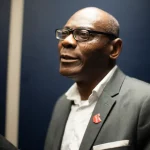At 10 years old, Ted Sun arrived to the United States as an immigrant, spending his first three years in Brooklyn, New York before moving to Ohio. A mechanical engineering graduate of the Ohio State University, and with two PhDs, Dr. Ted Sun is the founder of Transcontinental University and is contesting for the Dublin City Schools Board. He told the New Americans magazine that part of his desire to run was to “make sure the needs of our immigrant population is fully addressed.”
By Okon Ekpenyong
Public Education
Two opportunities for improvement are present in public education for K-12. We need to develop the entire student, rather than just the academic aspect. We’ve all seen how much we tend to forget after a quiz or test is over in traditional education. This happens in many parts of education, from K-12 to annual corporate training. Why are we continuing to invest our time and money into forgettable education? Developing the whole student calls for a different approach that engages critical thinking and long-term recall. It provides students with life skills such as time management, prioritization, and financial literacy. It helps our children develop emotional regulation to cope with the complexities of life, build empowering relationships with people from all walks of life, and allow our children to see their role within globalization so that they can get out of the comfort of Dublin.
Creating a consistent environment for our children to grow – The education system was created in the industrial revolution. Its purpose was to create a labor workforce. Many basic foundations like categorization, conformity, and control have not changed to adapt to the current needs of our business world. Education should not continue to exist within the walls of the school building.
Inclusive
An inclusive education guides parents, teachers, and administrators to create a consistent learning environment. Involvement is the key! Not only to show the children how to collaborate but also to experience the consistency of a learning environment that challenges them to grow at the pace they need.
Curriculum development is the second significant issue. Traditional perspectives only look at the contents of what to add and remove. Regardless of the content, students need to remember what they are learning, and a step-by-step system needs to be built irrespective of the individual student’s developmental needs. Adding topics based on politics is far from practical from a learning perspective.
Having adjusted curriculum in global universities and designed innovative ones for my institution means that curriculum development needs systemic thought to understand the individual student’s needs and develop the complete person. Teachers, learning materials, and the readiness of the student all need to be considered.
Gap
Dublin, like many other schools, is facing some educational gaps from the last pandemic year. Many students are not at where they should be for their age. Now that students are back in school, we need to make sure they get caught before the academic standards for their respective grades.
Mental health
As we attempt to emerge out of the pandemic, we’re pulled right back in, and it is taking a toll on our children. A recent conversation with a local pediatrician revealed that over 30% of her patients need medical treatment for mental health-related issues. The social-emotional well-being of children is not detected easily. Based on my experiences as an organizational psychologist who has worked with countless people on avoiding burnout, we need to be proactive in helping our children heal mentally so that they can focus on learning. We cannot wait until a child hurts themselves or others due to the lack of attention on their mental health. For any child to learn anything, they must be mentally available. I ensure preventative strategies are in place to support our children’s developmental needs while healing the trauma of the pandemic year. Our precious children deserve to be free from depression and burnout and live their lives as a sponge of learning.
Diversity
Our world is full of many challenges. The Diversity, Equity, and Inclusion, DE&! movement initiative is to address systemic racism. Unfortunately, numerous DE&I initiatives end up being simple, check-the-box activities by many companies and school districts. I have seen multiple directors of DE&I receiving paychecks for two years without any accomplishments in addressing systemic racism. Responsible spending, however, requires an accountability structure with objective metrics. We need to create and enhance systems that honor the diversity of the individual; support equitable development of our children, our teachers, and our staff, and create an inclusive culture where everyone has a voice.
Creating successful programs with outcomes like increased innovation means that our district can go beyond checking the box and develop our children in an inclusive environment that provides age-appropriate education.
Fiscal Challenges
Some of our funds are being redirected at the state level away from public education and spending, making sense for all stakeholders in recent years. Some past financial decisions have had negative consequences, such as teacher morale. We need to ensure we maximize funding for the district while also spending to make clear sense from a return-on-investment perspective. Having ample experience in effectively managing multi-million-dollar budgets, my conversations with various stakeholders have shown me numerous improvement opportunities.
Campaign
Besides the traditional methods like meet and greets, candidate forums, door hangers, postcards, and my round yard signs, I’m doing something that has puzzled others. I’m attending both republican and democrat events. I am not seeking or accepting any endorsements from any political or related groups to have the integrity to my commitment to uniting the community. In my short time in the elections, too much politics in being injected into school board elections when they are supposed to be non-partisan. My unique actions have gotten a lot of attention as well as criticism. A different approach to my school board candidacy is through education. As the only global educator in the group, I’ve run many workshops on critical topics such as diversity, equity, and inclusion, Critical race theory, and others. My work provides me with an in-depth understanding of these crucial topics and how they may influence our children’s education. Social media and google advertisements are also part of the promotion to spread the message that education has no sides – we should be focusing on the future of our children’s education based on scientific data.
Special education and English Language Learners, ELL
The district’s programs are significant to ensure that every student has specific needs that the school system can accommodate. The public education system should provide students with the means to thrive, which means accurately assessing student needs at the individual level and providing respective learning paths for success.
Quality Education
Numerous innovations are needed to improving access to quality education. It starts with proactive engagement with the parents/family of the children, who need to feel secure about the school taking their children on an educational journey. They need to feel included and supported, especially as their children may be learning content that they are not familiar with from their home nation.
The children’s individual needs also must be captured systemically so that every student has a learning profile that’s easily accessible and used by the teachers. This way, the teachers have the necessary knowledge about where the child’s developmental needs are when teaching the various subjects. With that information, the teachers can create the needed support structures for that child. For example, being a child with significant reading deficiencies, teachers can assign additional reading support to get caught up with reading skills while ensuring that the content of the reading materials is mastered.
Students
Student achievement happens on many levels. First and foremost, academic achievement is something that Dublin excels at in the past. The current environment significantly challenges this level of excellence as many are not at the same level as they should be after a pandemic year. Various levels of government have additional funding to help students get caught up, and the board needs to spend that budget wisely with clear accountability to address our students’ needs.
The board also needs to be well informed about district efforts such as social-emotional learning. With any new initiative, the board requires to ensure there is a clear accountability structure for successful implementation and not allowing alternative ideas outside the scope of the industry to creep into the programs.
Overall, accountability to student achievement has to be at the center of the board function, which requires metrics to ensure learning outcomes are achieved. These metrics need to provide timely feedback so that any initiative can be adapted immediately. If there are issues, corrective actions need to happen. As long as the leading metrics to student achievement are properly managed, they can predict desired student outcomes, such as the Dublin learner profile. This profile has many development areas that need clear metrics to assess student achievement in each area, such as creativity and innovation.
Budget
The primary focus of the school district is to help our children learn and grow into influential leaders. All budget priorities should be focused on ensuring this happens. Of course, there are numerous influences on student success, including teachers, curriculum, facilities, food, safety, etc. The long history of Dublin schools provides an excellent guide to making wise budgetary decisions. We need to always come back to being accountable for spending money that results in desired educational goals for our students.
Today, the Dublin school system exceeds 16,300 students, making the district the 10th largest in Ohio. With more families moving into the community/re-districting, what role would the board take to ensure the new kids are welcome and have the resources available to succeed?
As new students enter the school district, proper assessments are needed to place students into the right programs and align their grades with their age. Since each entering student will have unique educational needs, the board must make sure that each student gets that careful attention.
The feeling of welcome that leads to a sense of belonging is something that the individual school building would maintain. The board can ensure sufficient resources and time to welcome new students and continue student engagement to show them that they belong to one of the best districts possible.





































Leave a Reply
You must be logged in to post a comment.